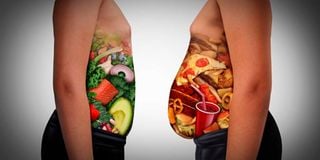Study: 30pc of schoolchildren in Kakamega overweight

Three in 10 schoolchildren in Kakamega County are overweight, with girls more affected than boys, according to a study done last year and published last week in the Journal of Advances in Sports and Physical Education.
Three in 10 schoolchildren in Kakamega County are overweight, with girls more affected than boys, according to a study done last year and published last week in the Journal of Advances in Sports and Physical Education.
The study, conducted by the Masinde Muliro University of Science and Technology, investigated the prevalence of obesity and factors that contribute to its occurrence among schoolchildren in Kakamega. The researchers, including Mr Micky Olutende, the lead corresponding author, warned that overweight children are at risk of developing chronic diseases, including type 2 diabetes, high blood pressure, hypertension and breathing problems.
The findings showed that type 2 diabetes was prevalent among obese pupils, compared to other chronic diseases. Also, the findings indicated a significant relationship between meals consumed, type of school, mode of transport and leisure activity and obesity.
The study sampled 400 children in 24 schools (public and private). The highest recorded weight in children below the age of 10 was 90 kilogrammes and the minimum was 18kg. The mean weight of the total population was 32kg. Of the 400 children, 43 per cent weighed 30–39kg, while 39 per cent weighed 50–59kg. At least 0.5 per cent of respondents had at least 60kg and 0.3 per cent were in the category of 70–90kg.
Consumption of chocolates
For those who were overweight, mostly from private schools, 85 per cent consumed foods that had a high caloric content, 51 per cent consumed foods that were dense in calories, while for those who were normal or underweight, the majority did not eat anything at break time.
There was a significant relationship between obesity and consumption of chocolates, baked items and fried items. The frequency of tuber consumption was low at 10 per cent. Tubers such as arrowroots, yams and cassavas are slowly disappearing from kitchen tables.
From the findings, seven of 10 children in private schools made an independent decision on what snacks they would carry to school, with 28 per cent of the children from public schools making the same decision.
“This is a clear indication of negligence among parents. They leave their children to learn and make wrong food choices, which later will impact their health. Most of the parents are not being good role models to their children,” says the study.
“A young child’s preference for snacks is related to what parents do or do not allow.
“Nutrition is essential to health and quality of life at every age. A normal healthy child grows at a genetically predetermined rate that can be compromised or accelerated by nutrition imbalance, overnutrition or undernutrition. The results of this study indicate that there was a significant relationship between dietary practices, meals consumed and obesity.”
According to the World Obesity Federation (WOF), 670,834 children in Kenya aged five to nine are likely to be obese by the year 2030. At the same time, 793,121 children aged 10 to 19 will be obese by 2030.
The data was collected using a questionnaire. The pupils who used school transport accounted for 32 per cent, those who walked were 30 per cent, those who used public transport were 24 per cent, while 17 per cent used private means to school.
Walked to school
A cross-tabulation between school type and mode of transport indicates that the majority of children 55 per cent from public schools walked to school while those attending private schools were only three per cent of those who walked to school.
Majorities at 96 per cent of children attending private schools used either school buses or were dropped to school by their parents.
“Most of the pupils in public schools came from poor socio-economic backgrounds. Thus, they could not afford to pay for school transport or public transport. They had to succumb to the long distances and harsh weather conditions to school,” says the study.
From the findings, eight out of ten children from private schools at 83 per cent spent their time watching television with 86 per cent playing computer games while seven out of ten children in public schools spent their leisure time assisting with household chores and 68 per cent playing.
Thirty-nine per cent of children who watched television were taken to school by bus while 36 per cent were dropped off by parents at school. Only 25 per cent walked to school while 44 per cent of those who engaged in household chores mainly walked to school.
“Most of the children attending private schools had house help who does all the household chores while they sit and watch television or play computer games while snacking. This predisposes them to a gradual increment of body weight and eventually develop obesity or overweight due to consumption of empty calories,” says the study.
The study findings found that 80 per cent of the meals that were offered in private school were high in fats, for example, chips and sausages, burgers and pizzas should be discouraged from schools.
In public schools, however, they did not have a range of food choices being offered at lunch hour. It mainly consisted of carbohydrate and protein nutrients.
Most of the children took their lunch with an additional can of sugars sweetened drink that they consume every day, this increases the risk of being obese by 60 per cent.
“Consumption of too many calories increases the chances of having excess body weight,” states the study.
It was observed in the study that four out of ten children who spent their time watching television were obese and 37 per who played video games were also obese.
The children who participated in household chores, mostly those in public schools, were normal or underweight.
As far as sports are concerned, 43 per cent of the children attended physical exercise lessons once a week slightly above a third 35 per cent stated twice, while the most times physical exercise was mentioned by only 15 per cent of the respondents.
Private schools had fewer reports on attendance of physical exercise lessons. This was because the students had many extracurricular activities incorporated into their school programme thus time slotted for physical activity was less.
It recommends that despite parents’ busy schedules they should try and at least have time for their children, plan and prepare meals together, go shopping together with their children, let them make choices of food with guidance, eliminate unhealthy foods from the house and avoid preparing high-fat convenience foods.




